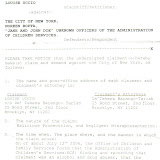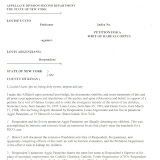Governments too often use faulty diagnoses to take children away from innocent parents
Written By: Michael Arnold Glueck and Robert J. Cihak
Published In: Health Care News
Publication Date: June 1, 2008
Publisher: The Heartland Institute
"[T]he medical profession and government officials often abuse the diagnosis of child abuse."
The loss of a child is one of life's most painful experiences regardless of the cause, whether illness, accident, or injury. Parents describe it as unbearable, never-ending pain.
But how about having your child or children forcibly removed from your home based on suspicion of a crime you didn't commit? Adding insult to injury, the accusations in question are based on an overzealous medical diagnosis. This is a reality faced by far too many parents accused of child abuse.
Yes, some parents abuse their children. However, the medical profession and government officials often abuse the diagnosis of child abuse.
False Charges
Since our column on "Temporary Brittle Bone Disease and Infant Fractures" appeared in 2005 (NewsMax.com, October 5, 2005), hundreds of parents, grandparents, attorneys, public defenders, other family members, and friends have contacted us about apparently false child abuse accusations.
Those that write present convincing stories of loving parents who would never abuse their children. They describe medical professionals and government officials instigating false charges, causing infants to be ripped from their mother's arms, essentially at the point of a gun.
In one such case, a mother described how her youngest, a four-month-old daughter, had multiple unexplained fractures. Because of suspicion of child abuse, government agents took all three of her children out of their home. The daughter had no bruising or other signs of trauma during eight previous well-baby medical visits.
Another person wrote us about a four-month-old grandson who had been found to have multiple fractures. The parents still had custody of the infant, but government agents were threatening to take him away.
TBBD Hypothesis
In our 2005 article, we explained how such a medical condition was possible without being caused by physical abuse. Our essay included information on clinical observations and research leading to the temporary brittle bone disease (TBBD) hypothesis.
While in their mothers' wombs, babies grow and develop at astonishing rates. Dr. Colin R. Paterson of Scotland discovered some babies' bones were prone to fracture during the first few months of life outside the womb. Since many of the fractured infants he examined lacked the bruises and internal injuries common to child abuse, Paterson hypothesized that these babies had a temporary form of brittle bone disease, different from osteogenesis imperfecta and other known medical conditions causing weak bones and multiple fractures.
Dr. Marvin Miller, professor of Pediatrics and Obstetrics and Gynecology at Wright State School of Medicine in Dayton, Ohio, recently reported 65 infants with a similar pattern of medical findings in the journal Medical Hypotheses (2005 65, 880-886). He hypothesized that these babies were tightly confined in the womb and hadn't got enough exercise to produce normal bone strength. Such confinement can be due to a number of causes, such as large fibroids, twins, or diminished fluid around the baby.
Diagnosis by Exclusion
After birth these babies are able to exercise more normally. Their bones grow even more rapidly than normal babies' bones, to catch up with the new demands of living outside the womb. This rapid growth can produce new bone in multiple layers and simulate healing fractures. In addition, some of the weak bones actually do break during normal care, such as during diaper changes.
About 50 years ago, diagnosing child abuse from X-ray images alone became popular. In medical jargon, these X-ray findings were said to be "pathognomonic" of child abuse.
An X-ray image is simply a snapshot of the result of an event or condition; it cannot reveal with 100 percent certainty what that condition's cause was. In addition, medical scientists continue to discover previously unknown medical conditions.
For example, a group including Dr. Roy Morello of the Department of Molecular and Human Genetics at the Baylor College of Medicine in Houston, Texas described a new genetic cause for brittle bones less than two years ago.
Based on current medical knowledge, and with only bone fractures as evidence, it is illogical to conclude an infant's injuries could only be due to child abuse. Such diagnosis by excluding everything else known to science, diagnosis by exclusion, is a logically false approach.
As physicians, we are grieved when medical professionals inadvertently abuse children by making diagnoses leading to false accusations of child abuse.
'Bounty Hunter' Incentives
In addition, some government social service workers face "bounty hunter" incentives. When they take children from their parents, especially when the move garners publicity, the government agents believe they gain by creating more "awareness" about child abuse--even when the charges are false. The agencies then refer to this publicity and generated "awareness" when asking the state legislature for more money so they can investigate, harass, and prosecute even more families.
New Procedures Needed
All other factors being equal, children thrive best when they grow up in their own parents' home.
As Voltaire said in 1747, "It is better to risk saving a guilty person than to condemn an innocent one." We therefore ask medical, social service, legal, and law enforcement professionals to review the problem of false accusations. Applying scientific advances and logic should result in new procedures for evaluating infants with healing bones.
Doctors, and especially radiologists, must earn patients' trust by not making unsupported diagnoses, such as determining child abuse based on X-ray appearances alone.
Because doctors and medical science cannot be presumed to be perfect, those accused must be presumed to be innocent until proven guilty. Justice must take precedence over the rush to convict.
Original Article-
Child Abuse Is Erroneously Over-Diagnosed - by Michael Arnold Glueck and Robert J. Cihak - The Heartland Institute
Subscribe to:
Post Comments (Atom)























No comments:
Post a Comment